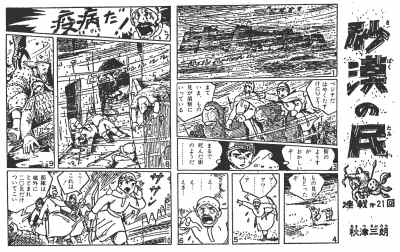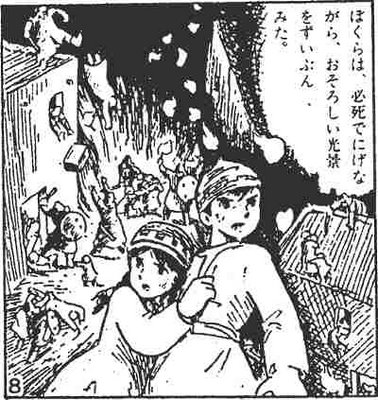 Sabaku no Tami, or "People of the Desert," was a weekly comic drawn by a young Hayao Miyazaki from 1969 to 1970. Published in Shonen Shoujo Shinbun, this comic provides an interesting look into Miyazaki's more serious, dramatic side. Dark, violent, and relentless; Sabaku no Tami examines humanity's destructive nature, following a trio of heroes over the course of war.
Sabaku no Tami, or "People of the Desert," was a weekly comic drawn by a young Hayao Miyazaki from 1969 to 1970. Published in Shonen Shoujo Shinbun, this comic provides an interesting look into Miyazaki's more serious, dramatic side. Dark, violent, and relentless; Sabaku no Tami examines humanity's destructive nature, following a trio of heroes over the course of war.Aside from Horus, Prince of the Sun, this really is the first time we see this serious side from him, which will evolve and mature over later animations like Future Boy Conan, and obviously Nausicaa of the Valley of Wind. We also see Miyazaki's clear love for romanticized cliffhanger serials, but the adventurous appeal of a Puss in Boots or an Animal Treasure Island is tempered heavily with a sense of the tragic. Blood is spilt, bodies fall, and one major character is killed in a dramatic escape attempt. The overall tone of the story is very grim, reflective of a young man whose early life was shaped by the aftermath of the Second World War.
The entire story, told in 26 episodes, is available online, thanks to an anonymous fan who has also translated much of the original plot. You won't follow every line of dialog, but you'll get the general thrust of it. The scans of each page are enormous, something I'm sure we're all grateful for, since it allows us to closely examine Miyazaki's complex and hyper-detailed compositions. Already by this point (as if Horus hadn't already established the fact), he has become greatly skilled as an artist.
It's also interesting to note how the look of the comic evolved. It begins with a few panels balanced with text, but over the course of weeks and months, the text is continually squeezed out, as more and more panels crowd their way onto the page. Eventually, we're left with that hyper expressionist arrangement of 8-12 panels that is Miyazaki's trademark. By comparison, most Japanese manga (comics) feature a small handful of panels per page. Miyazaki's approach is more Western-inspired - Mobius is an excellent example - and this also reflects his own deeply restless nature. He's literally bursting at the seams with endless ideas, champing at the bit to just completely take over. You can grasp his mindset just by examining the layout.
Of course, Miyazaki would get the chance to work himself to the bone, especially as the layout artist for all 52 episodes of Heidi, and all 52 episodes of 3000 Leagues in Search of Mother. But the work load doesn't break him, or drain away his energy, but fuels him. Yasuo Otsuka claimed that his tenure on Heidi and Marco turned him into The Hulk. I don't think he's diminished one iota in 40 years.
One last note on this panel that I've added below. It's a great illustration, so perfectly Miyazaki, with all the action in the background and the romantic heroes in the foreground. I'm sure you'll notice that the boy is the clear hero in this story, and the girl, while showing some strength, is taking a lesser role. All part of Miyazaki's own role-playing, in a sense. Watching his films for the first time several years ago, I naturally assumed that his Heroine was his avatar, Toshiro Mifune to his Kurosawa. But I don't think that's the case. I do believe the filmmaker inserts himself into the stories, but as the male romantic lead.
By the end of the '70s, the Heroine has completely taken over center stage, and the romantic lead, the adventure-minded boy, takes the supporting role on the side. It all leads, of course, to his great, androgynous Heroine in blue, and his greatest achievement - the 1,100-page Nausicaa manga. We're going to need a dump truck to plow through that one.
Read Sabaku no Tami here.


3 comments:
Very cool! I guess it's entirely too much to hope for that a work like this will ever get bought by a US distributor, translated and published in the States. Of course, I would have said the same thing seven or eight years ago about something like Osamu Tezuka's "Buddha," and that made it out in print in late 2003.
Hey! That's another book idea! Dagnabbit, stop that. My plate is already spilling over enough as it is.
It would be really cool to publish a book of Miyazaki's comics, such as People of the Desert, Animal Treasure Island, Puss in Boots, yadda yadda. Would probably make a better anthology than a series of seperate books, just for the sake of size.
Hi Daniel,
I think republishing these works in English would be a very important event ; not only from a fan perspective (which would be my primary perspective), but from an historical record perspective.
For most of us in the English speaking world (and including people like me who are currently studying Japanese but have not yet mastered the language) lack of availability of the text in English, published by US/British/Canadian/etc. press equates to complete ignorance of its existence. For example, I hadn't bothered to research several of the titles you referenced in your reply comment.
If these could be licensed, translated, and published for consumption in the English speaking market, I think knowledge of this aspect of Miyazaki's creative career would become much more widely known and he wouldn't *simply* be "that great animator from Japan" but also that wonderful "manga creator from Japan."
Anyway, too long of a comment, I guess! Sorry!
Chris
Post a Comment